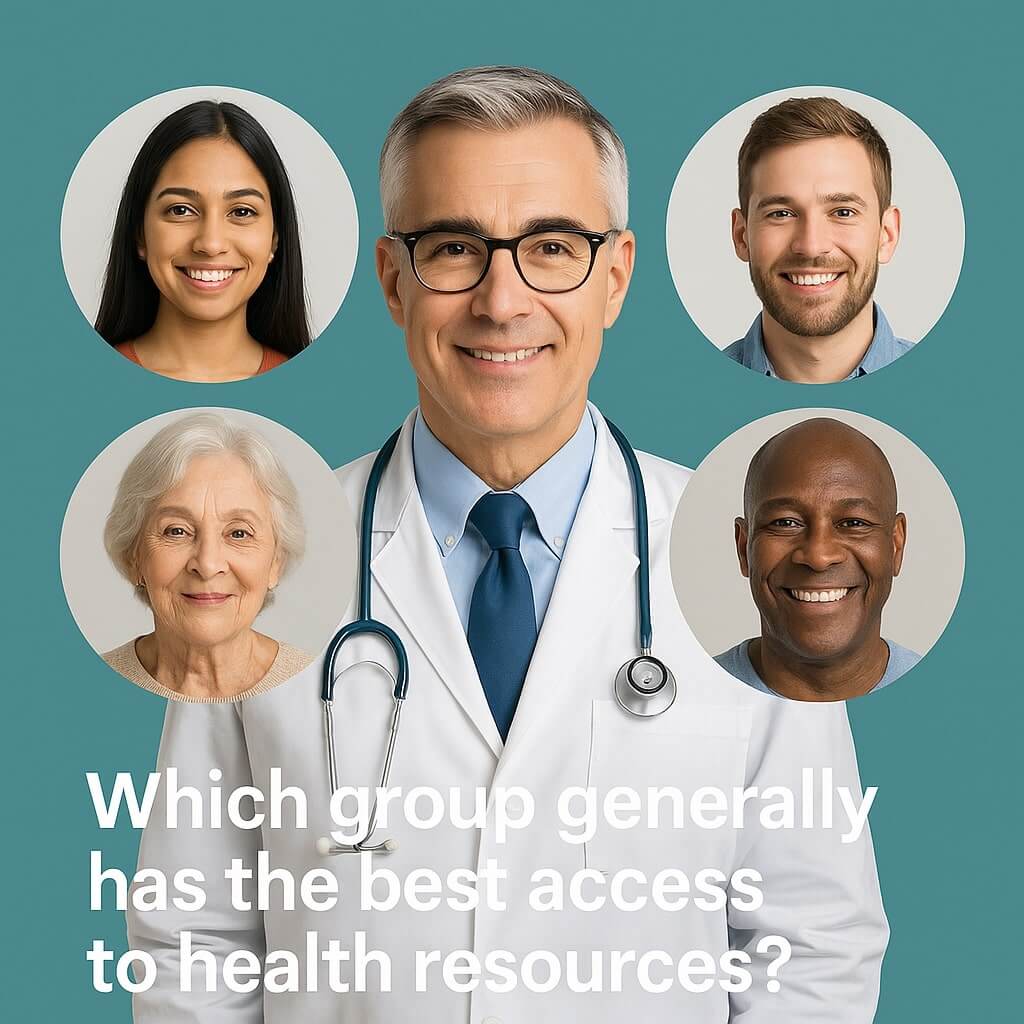When examining access to health resources, it’s clear that higher-income groups tend to have the greatest advantages. They often possess extensive insurance and the financial stability to seek care without major obstacles. Additionally, they usually live in areas with better healthcare infrastructure and resources. However, what about the implications of these disparities? Understanding the nuances behind these trends can provide valuable insights into potential solutions for improving access across all demographics.
Key Takeaways
- Higher income communities typically experience better access to healthcare resources and services.
- Individuals with higher education levels tend to have improved health literacy and decision-making capabilities regarding healthcare.
- Urban populations often have more healthcare facilities and options compared to rural counterparts.
- Those with comprehensive insurance coverage face fewer barriers and greater access to health services.
- Well-resourced communities often benefit from strong social networks that facilitate health information sharing and support.
Overview of Health Resource Accessibility
As access to health resources increasingly becomes a critical concern, understanding the factors influencing this accessibility is essential.
Health equity refers to the fair distribution of resources, ensuring that all individuals can obtain necessary healthcare. However, disparities exist due to uneven resource distribution, often influenced by socioeconomic status, geographic location, and systemic biases.
You’ll find that communities with higher income levels typically enjoy better access to healthcare facilities and services.
Addressing these inequities requires focused efforts on improving resource allocation and fostering environments where everyone can access quality health resources, ultimately leading to better health outcomes for all.
Demographic Factors Influencing Access
Income levels and education greatly shape your access to health resources.
Research shows that lower income often correlates with limited access to healthcare services, while higher education typically enhances health literacy, empowering individuals to make informed health decisions.
Understanding these demographic factors can help identify barriers and improve health outcomes across various communities.
Income Levels Impact Access
While various demographic factors influence access to health resources, income levels play a crucial role in determining the availability and quality of care individuals receive. Higher income typically correlates with better access to health services, reflecting significant disparities in wealth distribution.
Those in lower-income brackets often encounter barriers like inadequate insurance coverage and limited healthcare options. Income inequality exacerbates these issues, leaving vulnerable populations at a disadvantage regarding preventive care and treatment.
Education and Health Literacy
Education and health literacy greatly shape your ability to access and utilize health resources effectively. Understanding health information isn’t just about reading; it requires a foundation built on education.
Here are key factors influencing health literacy and education disparities:
- Educational Attainment: Higher levels of education correlate with better health literacy.
- Socioeconomic Status: Lower income often limits educational opportunities, impacting health knowledge.
- Language Proficiency: Non-native speakers may struggle to understand health materials.
- Community Resources: Access to educational programs can enhance health literacy in underserved populations.
Addressing education disparities is vital for improving overall health resource access.
Geographic Disparities in Healthcare Availability
Although access to healthcare is a fundamental right, geographic disparities considerably hinder individuals’ ability to receive necessary medical services. Rural healthcare often faces significant challenges, such as limited urban clinics and transportation barriers. In contrast, urban areas may offer more telehealth access but still lack cultural competence and language services. These disparities highlight the importance of community outreach and a well-distributed health workforce. Addressing social determinants and geographic isolation is essential for improving healthcare availability across all regions.
| Disparity Type | Impact on Access |
|---|---|
| Rural Healthcare | Limited services available |
| Urban Clinics | High demand, long wait times |
| Transportation Barriers | Difficulty reaching care |
| Telehealth Access | Uneven technology availability |
Insurance Coverage and Its Impact on Access
Insurance coverage greatly shapes your access to healthcare, creating disparities among various groups.
Policies can either enhance or restrict availability to essential services, particularly preventive care, which is vital for maintaining overall health.
Understanding these factors is key to addressing inequities in health resource access.
Coverage Disparities Among Groups
How can we address the persistent coverage disparities that affect various groups within society?
Understanding these disparities requires acknowledging the role of cultural competence and systemic barriers. Here are key points to reflect on:
- Increase Awareness: Educate healthcare providers on cultural differences to improve patient interactions.
- Expand Outreach: Target underrepresented communities to promote available insurance options.
- Enhance Accessibility: Simplify enrollment processes for insurance programs.
- Advocate for Policy Change: Support initiatives aimed at reducing systemic barriers to coverage.
Policy Influence on Access
Access to health resources is significantly shaped by policies that govern insurance coverage, which in turn influences the availability and quality of care individuals receive. Effective policy advocacy and healthcare reform are essential to guarantee equitable access.
| Policy Aspect | Impact on Access | Importance of Reform |
|---|---|---|
| Insurance Coverage | Determines care availability | Essential for equity |
| Policy Advocacy | Influences legislative change | Mobilizes community support |
| Preventive Services | Affects long-term health | Enhances overall outcomes |
| Affordability | Impacts patient decisions | Reduces barriers |
| Quality Standards | Guarantees care effectiveness | Promotes patient safety |
Preventive Care Availability
Preventive care plays an essential role in maintaining public health, yet its availability often hinges on insurance coverage policies. Access to preventive screenings and wellness programs can vary greatly, impacting overall health outcomes.
Here are key factors influencing this availability:
- Insurance Type: Public vs. private coverage affects the range of services included.
- Cost-Sharing: High deductibles can deter individuals from utilizing preventive services.
- Network Restrictions: Limited provider networks may restrict access to necessary screenings.
- Policy Gaps: Some plans may not cover specific preventive measures, reducing accessibility.
Understanding these factors is vital for improving preventive care access across populations.
Comparison of Access Among Different Populations
What factors contribute to the disparities in health resource access among different populations?
Cultural beliefs greatly influence how individuals perceive and utilize health resources. For instance, some cultures may prioritize alternative medicine over conventional healthcare, resulting in delayed treatment.
Cultural beliefs significantly shape health resource perceptions, often leading to preferences for alternative medicine over traditional treatments.
Additionally, social networks play an essential role in shaping health behaviors and access. Communities with strong social ties often share valuable health information and support, enhancing access to resources.
Conversely, marginalized groups may face isolation, limiting their ability to seek help. These elements underscore the complex interplay of cultural dynamics and social structures in determining health resource accessibility across populations.
Policy Implications for Improving Health Resource Access
While cultural beliefs and social networks greatly influence health resource utilization, effective policy interventions can bridge gaps in access for marginalized populations.
To promote health equity and optimize resource allocation, consider implementing the following strategies:
- Increase funding for community health programs targeting underserved areas.
- Enhance transportation services to improve access to healthcare facilities.
- Develop culturally competent training for healthcare providers to address specific community needs.
- Establish partnerships with local organizations to raise awareness about available resources.
These targeted approaches can markedly improve health resource access, ensuring that all groups benefit equitably from healthcare services.
Conclusion
In conclusion, higher-income groups typically enjoy the best access to health resources due to their financial stability, extensive insurance coverage, and favorable living conditions. These factors enable them to navigate the healthcare system more effectively, leading to better health outcomes. Addressing these disparities requires targeted policy interventions that enhance access for lower-income populations, ensuring equitable healthcare availability regardless of socioeconomic status. Ultimately, improving access for all is essential for fostering healthier communities.




